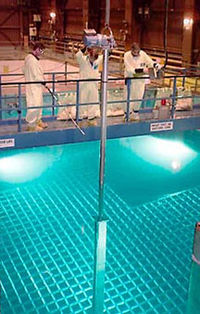
Photo from wikipedia
Fluoride‐salt‐cooled solid‐fuel fast reactor (LSFR) with thorium‐based fuel could complete a self‐sustaining core that fulfills long‐term energy demands. This paper further investigated the LSFR core sustainability of breeding thorium and… Click to show full abstract
Fluoride‐salt‐cooled solid‐fuel fast reactor (LSFR) with thorium‐based fuel could complete a self‐sustaining core that fulfills long‐term energy demands. This paper further investigated the LSFR core sustainability of breeding thorium and the spent fuel characteristics for closed fuel cycle. Two fuel recycle strategies were proposed in this paper, including U recycling and U/Pu/MA recycling, to evaluate the physical effects caused by these recycling some highly radiotoxic and heat producing minor actinides. Based on the two fuel management strategies, the sustainability of breeding thorium and the spent fuel characteristics from the 0th cycle core to the 8th cycle core were assessed, including radioactivity, radiotoxicity, and decay heat. It was found that both recycle strategies accomplished good breeding performance and reduced the 233U fuel inventory, implying that recycling nuclides could partially replace 233U. The U/Pu/MA recycling scheme possessed slightly better advantages in lower 233U loading and breeding performance, but this scheme accumulated more transuranium elements with cycle burnup because the LSFR core could not transmute MA for its relatively soft fast energy spectrum. In spite of this, the level of radioactivity, radiotoxicity, and decay heat for the discharge fuel in the 8th cycle core was either lower than or comparable to that of traditional PWR. It is worthwhile mentioning that between 1000 and 100 000 years the radioactivity, radiotoxicity, and decay heat production tend to grow again, which might require sophisticated storage design for LSFR core with thorium‐based fuel in the future.
Journal Title: International Journal of Energy Research
Year Published: 2021
Link to full text (if available)
Share on Social Media: Sign Up to like & get
recommendations!